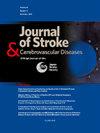More than half of patients with wake-up stroke have slept through their stroke onset
IF 1.8
4区 医学
Q3 NEUROSCIENCES
Journal of Stroke & Cerebrovascular Diseases
Pub Date : 2025-07-01
DOI:10.1016/j.jstrokecerebrovasdis.2025.108388
引用次数: 0
Abstract
Background
Conventional time-from-onset decision-making for use of reperfusion therapies in acute ischemic stroke is challenged by patients with wake-up strokes (WUS) in whom onset time is uncertain. Management of these patients, including use of advanced imaging to make “tissue-clock” rather than “time-clock” treatment decisions, and development of wearable technologies to detect stroke onset during sleep, would be aided by delineation of how often WUS patients had onset long before or shortly before awakening.
Methods
We performed a meta-analysis of studies comparing diffusion weighted imaging–fluid-attenuated inversion recovery (DWI-FLAIR) mismatch frequencies in patients with WUS compared with patients with clear onset time stroke (COS). Differences in FLAIR-DWI mismatch frequency between WUS and COS patients in matched time intervals from first symptom detection were analyzed in a novel manner to derive the timepoints during sleep of stroke onset in WUS patients.
Results
Two studies of WUS and COS patients met selection criteria, collectively enrolling 443 patients (201 WUS, 242 COS). For COS patients, mismatch frequency declined gradually as time from first symptom detection increased: <2 h 60 %; 2-3 h 53 %; 3-4 h 41 %; 4-5 h 37 %; 5-6 h 11 %. In contrast, for WUS patients, <2 h patients had similar mismatch rates to <2 h COS patients but mismatch then declined precipitously in all later time windows: <2 h 50 %; 2-3h13 %; 3-4 h 13 %; 4-5 h 6 %; 5-6 h 12 %. The lower mismatch rate indicated that 56.5 % of WUS patients had stroke onset long (2-8 h) before awakening and 43.5 % had stroke onset shortly (0-2 h) before awakening.
Conclusions
A majority of wake-up stroke patients stayed asleep for 2-8 hours after stroke onset, while a minority awoke at the time of or soon after onset. These findings can inform multimodal imaging strategies and wireless stroke detection technology development programs for patients with wake-up stroke.
超过一半的醒脑卒中患者在中风发作时一直在睡觉。
背景:在急性缺血性卒中患者中,起病时间不确定的唤醒性卒中(WUS)患者对传统的从发病时间开始再灌注治疗的决策提出了挑战。这些患者的管理,包括使用先进的成像技术来做出“组织时钟”而不是“时间时钟”的治疗决策,以及开发可穿戴技术来检测睡眠期间中风发作,将有助于描述WUS患者在醒来前很久或前不久发作的频率。方法:我们进行了一项荟萃分析,比较了扩散加权成像-液体衰减反转恢复(DWI-FLAIR)在WUS患者与明确起病时卒中(COS)患者中的不匹配频率。分析WUS患者与COS患者在首次症状检测匹配时间间隔内FLAIR-DWI不匹配频率的差异,得出WUS患者卒中发作睡眠时间点。结果:两项WUS和COS患者研究符合入选标准,共纳入443例患者(WUS 201例,COS 242例)。对于COS患者,随着首次症状发现时间的增加,错配频率逐渐下降。结论:大多数醒着的卒中患者在卒中发作后2-8小时保持睡眠,而少数患者在发病时或发病后不久醒来。这些发现可以为唤醒性卒中患者的多模态成像策略和无线卒中检测技术开发计划提供信息。
本文章由计算机程序翻译,如有差异,请以英文原文为准。
求助全文
约1分钟内获得全文
求助全文
来源期刊

Journal of Stroke & Cerebrovascular Diseases
Medicine-Surgery
CiteScore
5.00
自引率
4.00%
发文量
583
审稿时长
62 days
期刊介绍:
The Journal of Stroke & Cerebrovascular Diseases publishes original papers on basic and clinical science related to the fields of stroke and cerebrovascular diseases. The Journal also features review articles, controversies, methods and technical notes, selected case reports and other original articles of special nature. Its editorial mission is to focus on prevention and repair of cerebrovascular disease. Clinical papers emphasize medical and surgical aspects of stroke, clinical trials and design, epidemiology, stroke care delivery systems and outcomes, imaging sciences and rehabilitation of stroke. The Journal will be of special interest to specialists involved in caring for patients with cerebrovascular disease, including neurologists, neurosurgeons and cardiologists.
 求助内容:
求助内容: 应助结果提醒方式:
应助结果提醒方式:


